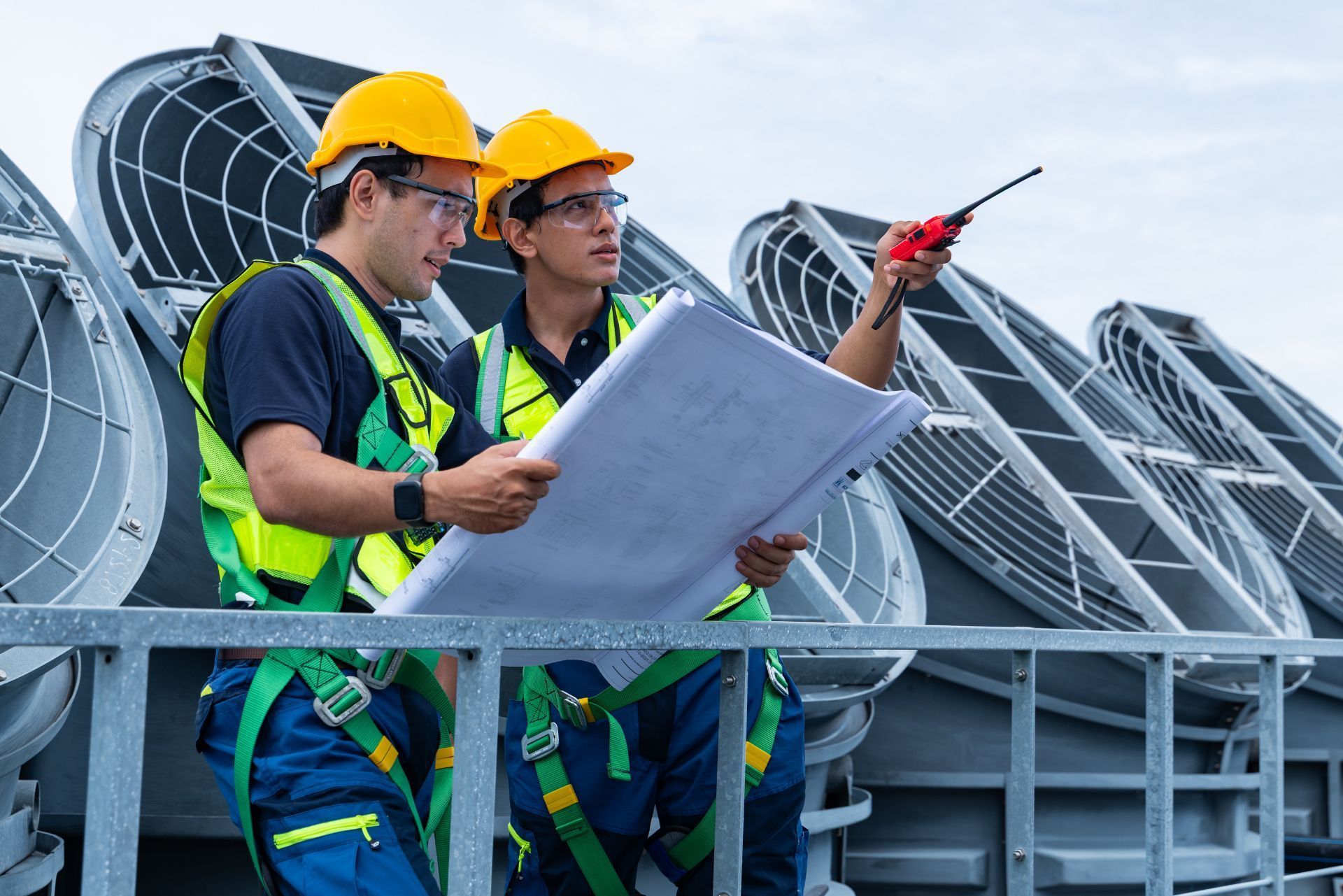Top 3 Recommended Policies

Working as a marine HVAC technician involves unique challenges and risks that differ significantly from those faced by land-based HVAC professionals. Whether you’re servicing heating, ventilation, and air conditioning systems on boats, ships, or offshore platforms, protecting your business with the right insurance coverage is essential. From liability risks to equipment damage, marine HVAC technician insurance safeguards your livelihood and ensures peace of mind while you focus on your specialized work.
Understanding the costs, coverage options, and state-specific factors can be daunting, but with expert guidance and the right information, you can find a policy tailored to your needs. This article dives deep into everything you need to know about marine HVAC technician insurance, including cost expectations, coverage essentials, and recent industry developments.
For a comprehensive overview of HVAC contractor insurance costs, Simply Business provides valuable insights that are relevant to marine HVAC professionals as well.
Why Marine HVAC Technicians Need Specialized Insurance
Marine HVAC technicians operate in environments that present distinct hazards compared to traditional HVAC work. Working on vessels means exposure to water damage risks, confined spaces, and the unique operational challenges of maritime equipment. These factors increase the likelihood of accidents or claims, making standard HVAC insurance insufficient.
General liability insurance is a must-have, but it often needs customization to cover marine-specific risks such as pollution liability, equipment malfunction at sea, and injury claims related to shipboard work. Without proper coverage, a single claim could jeopardize your entire business.
Industry experts emphasize the importance of partnering with knowledgeable insurance providers. As Michelle McDonald from BayCoast Insurance advises, teaming up with an industry expert is crucial for protecting your most important assets. This ensures your policy reflects the realities of marine HVAC work rather than a generic contractor package.
Moreover, the maritime industry is governed by a complex web of regulations and standards that vary by region and type of vessel. This complexity can pose additional challenges for marine HVAC technicians, who must navigate compliance with safety protocols and environmental regulations. Specialized insurance not only provides coverage for potential mishaps but also helps technicians stay informed about the latest legal requirements, thus minimizing the risk of costly fines or legal issues.
In addition to liability coverage, marine HVAC technicians may also benefit from policies that
cover equipment breakdowns, which can be particularly costly when working on a ship. The unique nature of maritime HVAC systems often means that repairs can be time-consuming and expensive, especially when parts need to be sourced from distant suppliers. Having insurance that covers these scenarios can help technicians manage unexpected expenses and maintain operational efficiency, ensuring that they can respond quickly to the needs of their clients while safeguarding their financial stability.

Understanding the Cost of Marine HVAC Technician Insurance
Insurance costs for marine HVAC technicians can vary widely depending on factors such as location, business size, and coverage limits. On average, HVAC contractors pay about $68 per month or $821 annually for insurance coverage, according to data from Simply Business. However, marine HVAC professionals may face higher premiums due to the increased risks associated with their work environment. The unique challenges of working on vessels, such as exposure to harsh weather conditions and the potential for accidents in confined spaces, contribute to the elevated insurance costs.
General liability premiums for HVAC contractors typically range from 1.3% to 2.6% of annual revenue, based on an analysis of over 1,100 insurance quotes reported by ContractorNerd. This percentage can help marine HVAC businesses estimate their insurance expenses relative to their income. Additionally, the type of work performed—whether it involves installation, maintenance, or emergency repairs—can influence the premium rates. Technicians engaged in high-risk activities may need to secure additional coverage, further impacting their overall insurance costs.
Location also plays a significant role. In larger states like Texas, insurance premiums are generally 20% to 30% higher than the national average, reflecting regional risk factors and regulatory environments. Conversely, states like Oregon see premiums about 20% to 30% lower than average. These regional differences should be considered when budgeting for insurance. Moreover, local maritime laws and the density of marine traffic can also affect the risk assessment performed by insurers, leading to variations in premium costs across different coastal areas.
For a detailed breakdown of typical insurance costs and how they compare across regions,
SBCoverage.com offers helpful insights into these geographic variances. Understanding these factors is crucial for marine HVAC technicians when selecting the right insurance policy. In addition to general liability insurance, many professionals also consider coverage options such as equipment insurance, which protects against loss or damage to tools and machinery, and
workers' compensation insurance, which is essential for safeguarding employees in case of workplace injuries. These additional policies can further influence the overall cost of insurance, making it vital for technicians to assess their specific needs and risks carefully.

Key Coverage Types for Marine HVAC Technicians
Marine HVAC technicians should seek insurance policies that address the specific risks of their trade. The following coverage types are particularly important:
- General Liability Insurance: Protects against third-party bodily injury, property damage, and related legal costs. USMC Insurance now offers general liability coverage with 2/4/4 limits tailored for HVAC contractors, which can be adapted for marine applications.
- Commercial Property Insurance: Covers damage to tools, equipment, and business property, including losses due to water damage or theft on docks and vessels.
- Workers’ Compensation: Essential for covering medical expenses and lost wages if an employee is injured on the job, especially given the hazardous marine environment.
- Pollution Liability: Addresses environmental damage claims, which are a unique concern in marine settings.
- Inland Marine Insurance: Protects equipment and tools while in transit or stored offsite, a common scenario for marine HVAC technicians.
It’s important to note that a basic general liability policy often doesn’t suffice. As highlighted by Quote Texas Insurance, coverage must be tailored to how you actually work to ensure comprehensive protection. Additionally, marine HVAC technicians should consider the unique challenges posed by working in confined spaces, such as engine rooms or below-deck areas, where ventilation and air quality are critical. These environments not only increase the risk of accidents but also complicate the installation and maintenance of HVAC systems.
Furthermore, the marine industry is subject to stringent regulations and standards, which can vary significantly from one jurisdiction to another. Compliance with these regulations is essential not only for the safety of the crew and passengers but also for the protection of the technician’s business. Failure to adhere to these standards can lead to costly fines and legal repercussions, making specialized insurance coverage even more vital for marine HVAC technicians. By investing in the right insurance policies, technicians can focus on their work, knowing they are protected against the unique risks of their profession.
How to Choose the Right Insurance Provider
Finding the right insurance provider is as critical as selecting the right coverage. Marine HVAC technicians should look for insurers with experience in both HVAC and marine industries, as these providers better understand the nuances of your work and can offer customized policies.
When evaluating providers, consider their reputation, claims handling process, and willingness to tailor policies. Working with brokers or agents who specialize in contractor insurance can simplify this process and help you avoid costly coverage gaps.
Additionally, some insurers now offer specialized packages for HVAC contractors, including those working in marine environments. For example, USMC Insurance’s recent introduction of general liability coverage with specific limits for HVAC contractors shows a growing recognition of the unique needs of this trade.
It's also essential to assess the financial stability of the insurance provider. A company with a strong financial rating is more likely to meet its obligations when claims arise. Look for ratings from agencies such as A.M. Best or Standard & Poor’s, which evaluate an insurer's ability to pay claims based on their financial health. This step can provide peace of mind, ensuring that your provider will be there when you need them most.
Moreover, consider the customer service aspect of the insurance provider. A responsive and knowledgeable customer service team can make a significant difference, especially during stressful situations like filing a claim. Reading customer reviews and testimonials can provide insight into how well an insurer supports its clients. Engaging in discussions with current policyholders can also shed light on the insurer's reliability and responsiveness, helping you make a more informed decision.
Tips for Reducing Insurance Costs Without Sacrificing Coverage
While insurance is necessary, managing costs is equally important for small and medium-sized marine HVAC businesses. Here are some strategies to keep premiums affordable:
- Maintain a Strong Safety Record: Implementing rigorous safety protocols reduces the risk of accidents and claims, which can lower premiums over time.
- Bundle Policies: Purchasing multiple coverages, such as general liability and commercial property insurance, from the same provider can lead to discounts.
- Increase Deductibles: Opting for higher deductibles can reduce monthly premiums but requires readiness to cover more out-of-pocket expenses in the event of a claim.
- Regularly Review Coverage: As your business grows or changes, adjust your insurance to avoid paying for unnecessary coverage or being underinsured.
Given that 67% of HVAC contractors pay between $25 and $95 monthly for insurance, according to Simply Business, there is a reasonable range within which marine HVAC technicians can aim to keep their costs while ensuring adequate protection.
Another effective strategy is to invest in employee training programs that emphasize safety and efficiency. By educating your staff on best practices, you not only enhance workplace safety but also foster a culture of responsibility that can lead to fewer claims. Additionally, some insurance providers offer incentives for businesses that actively engage in training, which can further reduce your premiums. Furthermore, consider leveraging technology such as tracking systems and performance analytics to monitor safety compliance and operational efficiency, which can also be beneficial in negotiating better rates with insurers.
Lastly, staying informed about industry trends and changes in insurance regulations can provide significant advantages. Engaging with professional associations or networks can offer insights into emerging risks and best practices that may affect your insurance needs. By proactively addressing these factors, you can better position your business to negotiate favorable terms with insurers, ensuring that you not only save on costs but also maintain comprehensive coverage tailored to your unique operational challenges.
Conclusion: Protecting Your Marine HVAC Business for the Long Term
Marine HVAC technician insurance is not just a regulatory formality—it’s a vital safeguard that protects your business, employees, and clients from the unique risks of maritime HVAC work. Understanding the nuances of insurance costs, coverage options, and regional factors enables you to make informed decisions that align with your business needs.
Partnering with industry experts and choosing tailored policies ensures you’re not left vulnerable by generic coverage. As the marine HVAC field continues to grow, staying informed and proactive about insurance will help secure your business’s future.
For those seeking specialized policies and expert advice, resources like USMC Insurance’s HVAC contractor coverage provide a great starting point to explore options designed specifically for your trade.
Contact Us
